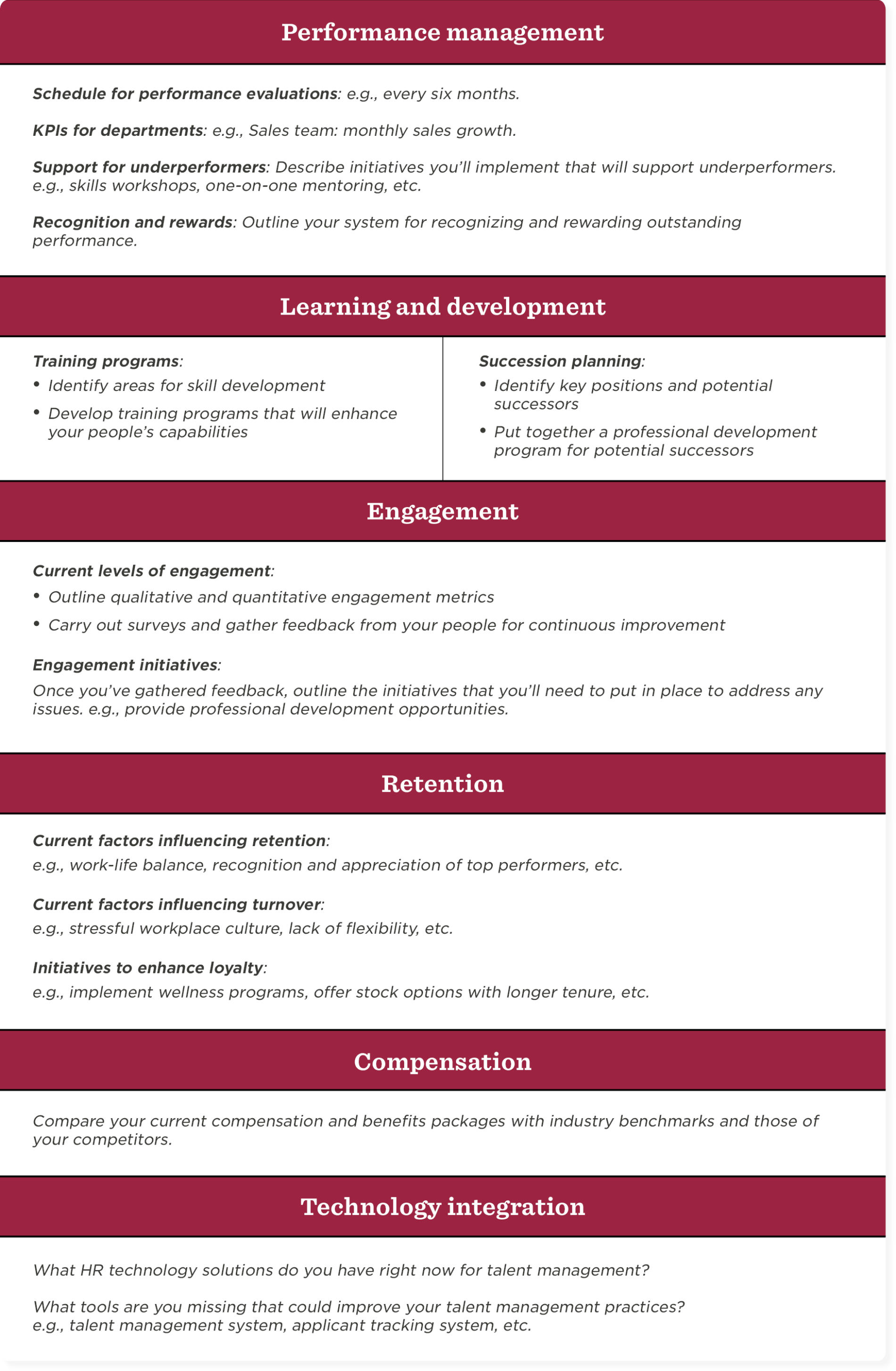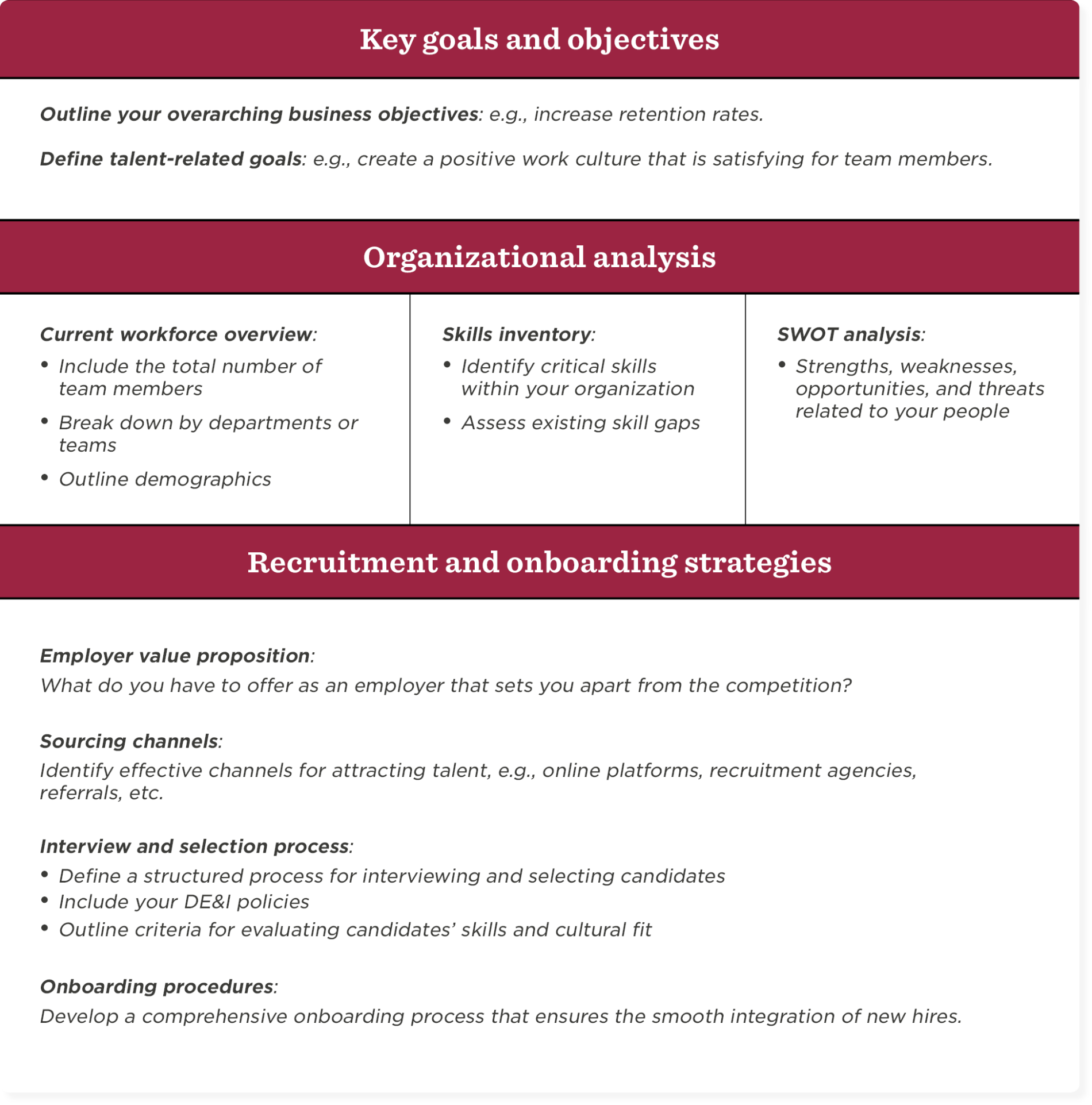HR leaders today need to create a talent management strategy and make it an integral part of what they do. With an effective talent management strategy template, you have a clear plan and process that unlocks your people’s potential and helps your organization succeed.
In this guide, you’ll discover everything you need to know about strategic talent management, along with a talent management template example that’ll help you develop your very own strategy.
<<Print this talent management strategy template and bring out the best in your people.>>
What is a talent management strategy?
A talent management strategy outlines how an organization intends to attract, develop, and retain top talent. It addresses challenges at different phases of the talent lifecycle, from revising recruitment practices to increasing retention.
A strong strategy gives HR and leadership a focused plan for where to improve and how to make those improvements last.
Why it’s important to have a strategic talent management plan in place
Companies with strong talent management practices have nine percent greater revenue growth than their competition. With a clear strategy, you can align your people’s abilities with company objectives and achieve those results. A strategic talent management plan can help:
- Make the hiring process more efficient: A strong strategy helps you define what success looks like in each role—skills, experience, and cultural fit—so you can hire good people faster. Instead of relying on gut instinct, your hiring team can have a better idea of which candidates are most likely to deliver results.
- Improve workforce planning: Planning ahead becomes easier when you can spot skill gaps, anticipate team growth, and match talent to business needs. A clear strategy gives you the data and structure to prevent under- or overstaffing.
- Nurture high-performing individuals for succession: With the right tools for visibility, you can identify team members with leadership potential early on. A good strategy can help build tailored development plans, assign projects that bring out leadership qualities, and ensure they’re ready to step into critical roles when needed.
- Encourage your people’s skills: A good plan connects skill-building to real-life job performance. Leaders can use performance data and team feedback to guide upskilling, reskilling, and learning paths tailored to each person’s goals.
- Increase engagement and satisfaction in the workplace: When people see a clear path forward and feel supported in their development, engagement naturally follows. This means fewer disengaged team members and more who collaborate, innovate, and go the extra mile.
- Boost retention: People stay longer when they feel their growth matters. A talent management strategy that includes regular career conversations, coaching, and recognition helps you retain high performers and reduce the costs of backfilling roles.
- Ensure business continuity and adaptability: When talent planning aligns with your long-term goals, you’re better prepared for the unexpected. Whether it’s a shift in the market or internal change, you can pivot faster without pausing progress.
How to develop your strategic talent management plan
Creating a strategic talent management plan starts with one key ingredient: understanding your people. It’s not just about filling roles; it’s about building a workplace where people thrive, grow, and stay engaged for the long haul.
Assess your current talent lifecycle
Before building a forward-thinking talent management plan, it’s important to understand where you stand today. Mapping your current lifecycle helps uncover strengths to build on—and gaps to address. From the first interaction with a candidate to the final farewell, every stage offers valuable insight into your people’s experience.
Evaluate each part of your lifecycle, including:
- Recruitment: Are you attracting the right talent? Do your recruitment processes need to be more efficient? Are there any skill gaps in your organization?
- Onboarding: Is it easy for new hires to become familiar with their roles and feel at home in their new work environment?
- Engagement: Do your people feel committed to their work? What do they need? Do they feel satisfied in the workplace? Are they productive?
- Learning and development: Are you putting initiatives in place that nurture your people? Are there professional development pathways for future leaders?
- Offboarding: Do departing team members leave with a good impression of your company? What’s influencing turnover rates at your organization?
Clarify strategic organizational goals
Define the business goals that matter most in the next months or years. Are you aiming to enter new markets, increase revenue, or launch new products? These priorities should shape how you recruit, develop, and retain talent.
For example:
- If you’re expanding into a new region, you may need multilingual people with local market knowledge
- If you’re focused on product innovation, look for skills in emerging technologies or creative problem-solving
- If retention has been a challenge, emphasize internal mobility and development programs to keep top performers growing in-house
Tie each talent initiative directly to a business goal so every HR action supports the company’s big picture. This alignment makes it easier to track your impact on organizational success.
Determine talent management metrics to measure
Once your goals are clear, figure out the talent management metrics that will show whether you’re on the right track. These metrics should reflect your objectives, giving you a tangible way to measure progress and the impact of your talent management efforts.
Armed with goals and metrics, you’re ready to sketch out a practical talent management plan. This plan acts as your strategic guide, laying out the necessary steps to improve talent acquisition, development, and retention. It ensures that your talent management aligns seamlessly with your broader organizational goals, contributing to sustained success.
Identify capabilities needed to achieve business strategies
Look closely at where your teams excel—and where they need support in order to achieve business goals. For example, if you’re pivoting toward automation, look for areas where manual processes slow things down. Or, if you’re preparing to launch a new product, you might need stronger project management or technical training for customer-facing teams.
Then, plan how to fill those gaps—whether through hiring, upskilling, or adjusting team responsibilities. Taking the time to match your business goals with specific capabilities helps you focus resources where they’ll have the most impact.
Create a strategic talent management team
Your strategy will need a team to execute it properly. Start by identifying the right people to lead the charge. This might include HR leaders, department heads, and executives who understand your workforce challenges and company goals.
Their job is to both plan and execute at the highest level. This team will outline priorities, assign responsibilities, and track progress. They’ll also act as internal advocates, making sure everyone understands the “why” behind the strategy and stays committed as it evolves.
Include time for training
Your new processes will work best if your people know how to use them. If you’re rolling out an updated performance review system or launching a new internal mobility program, don’t assume team members will figure it out on their own.
Make it easy for managers to adopt with short walkthroughs or live sessions. Give teams hands-on time with any new tools or dashboards, and clarify where they can go for help. Even 30 minutes of targeted training upfront can save hours of confusion down the line and build trust that your HR initiatives are there to support.
<< Make adoption easier with a free talent management strategy template. >>
Your talent management strategy template
The great news is that you don’t have to build your strategy from scratch. The template below will walk you through the steps for developing an effective talent management framework for your organization.
Example talent management template:

<< Set your rollout up for success with a free talent management strategy template. >>
Talent management strategy examples
Here are some companies that significantly improved their business by implementing a strong talent management approach.
The Brand Power Company
As a global advertising agency, The Brand Power Company implemented a talent management strategy to grow its worldwide team. With teams across 11 countries, they needed more than just basic HR admin tools, so they looked for a unified platform that could support development, recognition, and performance at scale.
They used HiBob’s Talent module to launch structured performance reviews and tied those reviews directly to internal promotions, improving engagement with career development. They also localized time-off policies, streamlined compensation planning, and used survey insights to help leaders better understand and support their people.
With Bob, their talent strategy became more proactive and empowered managers to make smarter, data-informed decisions across regions, even while remote.
Starbucks
Restaurants and cafés can have high turnover rates, with many businesses facing an average annual turnover rate of 79.6 percent over the last ten years. Yet, despite this, Starbucks has been able to keep its turnover down to 65 percent. What’s its secret?
Starbucks developed a competitive talent management strategy that takes care of its people. The organization provides healthcare, professional development, and income protection—among other benefits—to both part-time and full-time team members.
Investing in a talent management strategy that puts its people first means Starbucks has been able to stand out from the competition.
Hyatt Hotels
World hospitality leader Hyatt has also reaped the rewards of an effective talent management strategy. Hyatt’s mission statement is to “care for people so they can be their best.” The organization decided to put this philosophy into practice when it came to its talent management strategy.
Hyatt’s senior management team carried out extensive research throughout their branches in 60 countries to gain a deep understanding of their people’s needs. The insights they gathered from listening to team members triggered an extensive HR transformation that resulted in the following:
- An improved employee experience
- Training and development initiatives for leaders within the organization
- Implementation of HR tech that made processes more efficient
Eventbrite
Where better to look for inspiration than at a company with a reputation for being one of the best places to work? Eventbrite didn’t always enjoy that reputation. During its rapid expansion, it struggled with high turnover rates, low productivity levels, and low engagement.
CEO Julia Hartz realized there was a desperate need to transform the organization’s talent management practices. So, Eventbrite developed and implemented a new strategy that encouraged open feedback from team members. It listened to that feedback and provided flexible working arrangements and development programs for its people. It worked.
Eventbrite’s people felt satisfied, productivity increased, and turnover rates plummeted. This contributed to the continued success of the organization and its excellent employer brand.
Best practices for implementing an effective talent management strategy
Here are a few best practices to keep in mind to ensure your talent management plan has the greatest impact:
1. Focus on your people
Effective talent strategies start with listening. Open the door to honest feedback and act on what you learn—whether it’s enhancing the employee experience, investing in learning opportunities, or introducing wellbeing programs that show your team they matter.
Embedding diversity, equity, inclusion, and belonging (DEI&B) into every stage of your plan ensures you’re meeting the needs of everyone in your organization—not just a few. Inclusion isn’t an add-on; it’s essential for impact.
2. Encourage growth
Professionals often leave roles to find career development elsewhere. Build clear, meaningful growth paths to keep top talent engaged—and progressing. Offer upskilling, mentoring, or leadership programs that help people see a future within your organization.
Growth also supports long-term planning. When your people level up, recruitment teams can promote from within and plan for succession with confidence.
3. Make the most of HR tech
With the right tools, strategic talent management becomes easier to implement—and measure. The platform and other modern HR tech solutions streamline processes, track key metrics, and help teams stay connected to their people.
Here are a few tools that can support your strategy:
- Talent management systems: This specialized software helps you address the different functions of talent management, including recruitment, performance management, learning and development, and compensation.
- Applicant tracking system: An ATS makes your recruitment processes more efficient, helps you attract applicants with the right skills, and increases candidate engagement.
- Employee experience platform: These platforms help you create a positive work environment for your people. It gives you tools for gathering feedback from team members, managing performance, and improving communication and collaboration.
- Employee recognition software: Recognition software makes it easy to acknowledge and reward high-performing team members, contributing to a supportive working culture.
- All-in-one HR software: These all-in-one systems bring everything into one place— from onboarding and time-off tracking to performance reviews and compensation —so you’re not jumping between tools.
4. Communicate clearly
Organizations can sometimes overlook the need for transparency and clear communication when implementing a talent management strategy. This involves gathering the insights of stakeholders, updating them on progress, and making it clear to your people that you care about them and want to improve.
5. Improve continuously
Like any good HR strategy, it’s important to regularly assess and adapt your talent management plan to stay on track. Schedule periodic reviews of your strategy and initiatives and gather feedback from your people. Staying flexible in this way ensures you reap greater and greater rewards from your talent management strategy.
Bring out the best in your people with proper talent management
Talent management refers to an organization’s various practices to attract, develop, and retain valuable professionals. It affects all stages of the talent lifecycle and significantly affects your company’s success.
Using the talent management strategy template above and following the suggested best practices, you can develop a talent management plan that brings out the best in your people and leads your organization to greater heights.
<< Bring out the best in your team with a free talent management strategy template. >>
Talent management strategy FAQs
What is talent management?
Talent management is the strategy of how companies find, develop, and support the people who drive their business forward. It covers the entire employee lifecycle, including onboarding, performance reviews, learning opportunities, internal mobility, and long-term career growth. Talent management helps you answer questions like:
- Are we hiring the right people for where we’re headed?
- Do our managers know how to support their teams?
- Are we giving people opportunities to grow, or are we pushing them to leave?
Effective talent management builds a strong, motivated team that stays aligned with the company’s goals as it grows.
What are the key components of talent management?
Talent management is the combination of several connected efforts that support your people at every stage of their journey. Some of the most important building blocks include:
- Workforce planning: Looking ahead to anticipate talent needs, whether it’s backfilling roles, launching new teams, or shifting focus based on company goals
- Recruitment and onboarding: Attracting qualified professionals and helping them integrate into the company with clear expectations and support from day one
- Performance management: Setting goals, providing feedback, and tracking progress year-round to drive individual and team success
- Learning and development: Offering opportunities to upskill, reskill, or grow into leadership roles through structured training and mentorship
- Engagement: Creating a positive work environment where people feel connected to their work, team, and company values
- Succession planning: Identifying future leaders and giving them the tools and coaching needed to grow into critical roles
Recommended For Further Reading
- Hiring? Here are 2025’s big recruiting challenges
- Collaboration is key: HR, hiring managers, and optimizing your recruitment strategy
- Free job description template to streamline recruiting
- Simplify talent recruitment: Your hiring process checklist
- 12 best talent management software for small businesses
What is a talent management process?
The talent management process is the step-by-step approach companies use to attract talent, support team members, and grow qualified people into leaders. Instead of individual HR activities, it connects each step of the team member lifecycle into a repeatable, scalable process. Here’s how it typically works in practice:
- Start with workforce planning: Review current and future business goals, then map out what skills, roles, or headcount you’ll need to get there
- Launch strategic hiring: Build job descriptions, define selection criteria, and recruit candidates who align with your culture and goals
- Deliver structured onboarding: Make sure new joiners have the context, tools, and guidance to contribute quickly and confidently
- Engage and support the team: Keep people motivated and connected with regular check-ins, recognition, and wellbeing initiatives
- Invest in continuous development: Provide learning opportunities that help people grow in their current roles or step into new ones
- Prepare for future transitions: Use succession planning to keep your bench strong for future leadership needs
What are the objectives of talent management?
The main goal of talent management is to build a workforce that’s engaged, capable, and aligned with the company’s mission. That means attracting skilled professionals who fit your culture, creating a sense of belonging that encourages them to stay, and supporting their growth through ongoing development.
Supporting team members with opportunities to learn and advance can help them deliver stronger results and contribute to business success. Talent management also focuses on the future—building a pipeline of upcoming leaders who can step into critical roles as the company evolves.
When done well, it improves both organizational performance and the day-to-day experience of your people.

